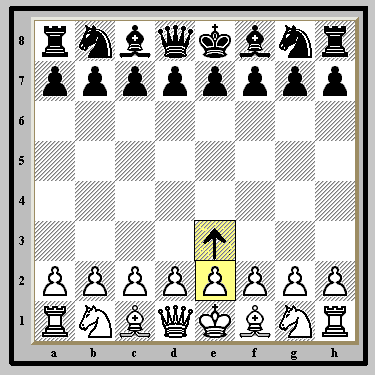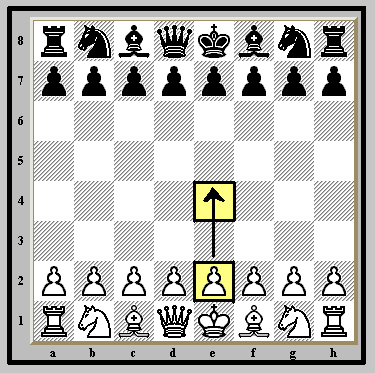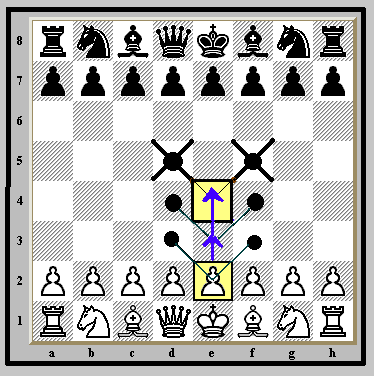All
the |
(Navigation bar
directly below.)
*******
© A.J. Goldsby, 2015.
(All rights reserved.)
****************
Click HERE
to see my
Chess Items.
****************
****************
Buy a book
from Amazon.com
(And help me out as well!)
****************
Click HERE
...
to see a list of the businesses that help to sponsor all of
my chess efforts.
"The Pawn(s)" In Chess
***********************
The Soul of the Game
(Or, 'Life in the Infantry'.)
Click HERE to return to my Training Page.
Click
HERE to return to my HOME Page.
________________________________________________________________
Click HERE to go to another site where the basics of chess are covered.
Click HERE to go to another site where the basics of how the pieces move are covered.
The Pawn is the "Ground-Pounder" of the chess-board.
He is the most basic unit. His movement and capturing power can be traced directly to the lowest ranked soldiers of the armies of the 15th and 16th centuries.
He is the unit of lowest-value, and normally the most expendable.
His worth increases as he travels up the board, because a pawn that reaches the other side of the chessboard gets to promote!
In the middlegame, or during "The Big Brawl," the pawns often just get in the way of the other pieces.
In the endgame, sometimes having just one extra pawn can make all the difference.
Grand-Master's (The highest, and most exalted class of chess-players.); know that how you stage and array your pawns {i.e. Pawn Structure} is very critical to the game. Masters will generally win by taking a pawn from you in the early stages of the game, then beating you with that one point difference!!
(Take a close look at the picture/diagram below.)

(In the diagram above, The Pawn on e2 may advance one square to the e3-square. This possibility is shown above.)
The pawn is the simple foot - soldier of the chessboard. The pawn moves straight ahead his whole life, mostly moving one square at a time. A pawn NEVER moves backward.
(The fact that the Pawn cannot move backwards makes it unlike any of the other pieces in Chess. The King, Queen, Rook, Knight, or Bishop can all move forward, backwards or sideways; as long as they conform to the correct movement-pattern for that piece.)
The pawn begins his life on your second row, and you will always have eight Pawns on your second row when you begin the game.
You may move a pawn/ any pawn that you wish on your first
move.
(You may also move one of your Knights to any one of the open squares which are available to them.)
It is a very unique and strange thing, but the pawn is
the ...
ONLY PIECE
that moves one way, and then captures another!! This is very
important to
remember, and you must bear this in mind at all times!
Pawns capture one square ahead, to the right or left; in the same general direction as their movement. ---> I.e., a pawn on e4 could capture any piece on d5 or f5.
(First Move Option.)

(The above diagram shows that White has the choice of
moving
his pawn on e2 to the e4-square.)
The Pawn also has the option of moving forward TWO squares, on the first move only! This is an OPTION. This means you do NOT have to make this move, unless you want to!
A
Pawn, any pawn, may move forward ... TWO SQUARES on its FIRST MOVE ONLY!!
After a pawn has moved on its first move, it then moves one square at a time, (Moving straight ahead, or capturing one square to the right or left.); for
THE REST OF THE GAME!
(Movement and capturing with a Pawn.)

The above picture shows the possible movement of the e2-Pawn on its first move. It may move to e3, or to e4. Once it arrives on e4, it could capture any enemy piece that landed on the d5 or f5 squares.
***
(Capture squares [for a pawn on e4] marked by the large, bold, black X's.)
Additionally, if the e2-pawn is not moved on your first move, it could capture
any piece that happened to land on the d3 or f3 squares.
***
(Potential movement of the e-pawn, is designated by the blue arrows.)
***
[Or if the pawn on e2 moved to e3, it then could capture any piece that then was moved to the d4 or f4 squares.
***
These (potential capture) squares of the e-pawn (on e2, e3 or e4) ...
are marked by the large, black dots.]
One other thing to remember about the Pawn is that if it makes
its way all the way to the other side of the board, then it may be PROMOTED to
any piece of your choosing. (Except a King.) That is it may [must] be instantly
(!) replaced by a Queen, Rook, Knight, or Bishop. This is a
permanent solution.
Once the Pawn reaches the Promotion Square, it then assumes the movement power of that piece and NO LONGER moves like a Pawn!
This about does it for the discussion of the Pawn. There is one special move, (Pawn X Pawn, en passant.); and this will be covered in a separate section on Special Moves.
Properties of the Pawn
Having
said a little about the Pawn, we should probably outline some
of the basic properties of this particular unit of the chess-board.
***
# 1.) Since Pawns CANNOT move backwards, you should be very, very sure you want to push a Pawn before advancing it. Think twice before moving a Pawn!
#
2.) The way the Pawns are arranged on the board is essential. Great
care and thought should be given to the way you are going to use your Pawns. The
'holes' or gaps in the Pawn structure will determine how much activity your
pieces have. Look for these open
lines for your pieces to occupy.
---> Open files are critical for
Rooks. Open diagonals are critical for
the Bishops.
# 3.) The further Pawns move up the board, the stronger they become! This is a very simple axiom that is often over-looked even by the most experienced chess-player. A pawn that is only a few moves from reaching its "promotion square" should be constantly watched. Combinations involving this motif are especially tricky!
# 4.) A weakness in the Pawn Structure can often bring about the loss of the game. Learn what a 'doubled' pawn is, what an 'isolated' pawn is, what a 'backward' pawn is.
---> Make it second nature to avoid these weaknesses at all costs.
That's
it! Now you know almost everything about the pawn.
NOT all that bad, yes?
***********************
Copyright (c) A.J. Goldsby I; © 1975-2014; © A.J. Goldsby, 2015.
(Page last updated: Monday; May 31st, 2004. Last edit or save on: 02/12/2015 13:22 .)
Copyright (c) A.J. Goldsby, 2015. All rights reserved.
Click
HERE to go to the next page of my Learning Course,
"The King"
in Chess.
